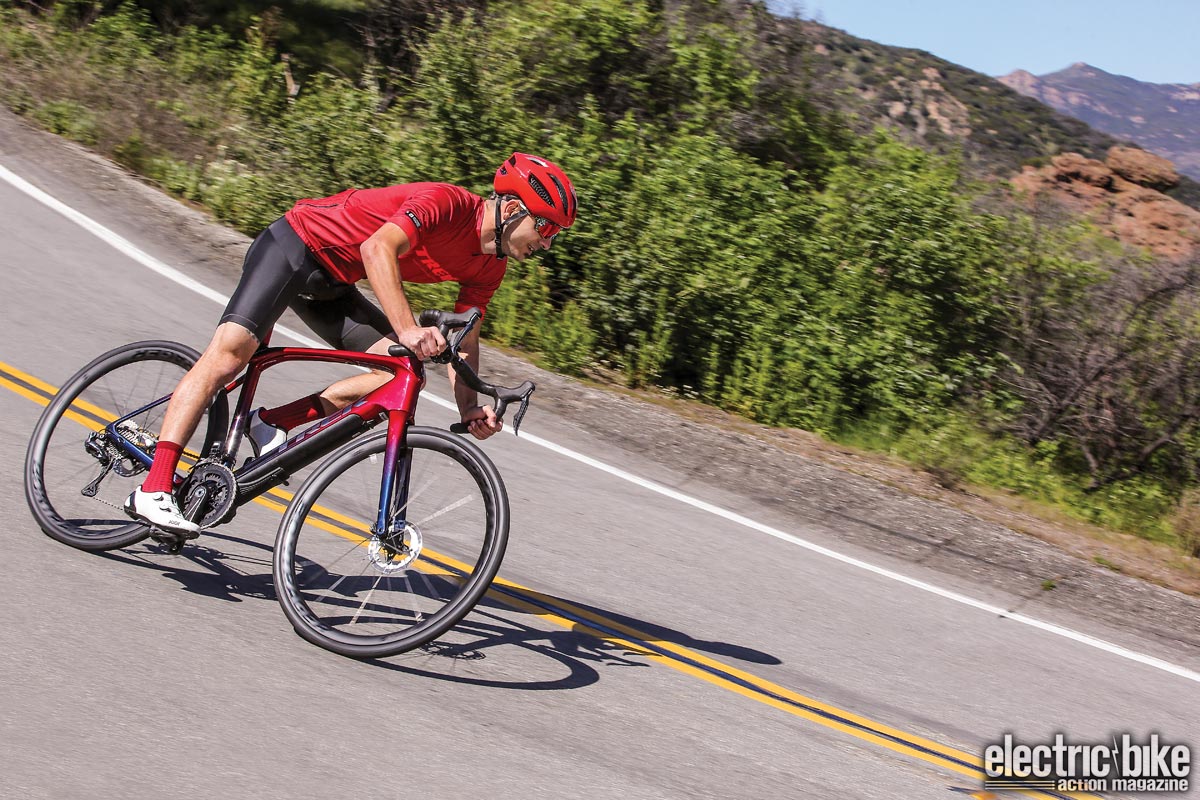Road Bike Shootout: Trek’s Domane+ LT 7 Vs. BMC’s AlpenChallenge
an internal width of 20mm, external width of 24mm and are 32mm deep. A pair of 30mm Vittoria Corsa Control TLR G+ tires are mounted, as are the 180mm front /160mm rear rotors.
For the “e” in e-bike, the Shimano STEPS system pairs perfectly with the drivetrain. The Shimano E-8000 motor with 250 watts at 70 N/m output is bolted to the frame. An external Shimano STEPS BT-E8010 battery with 504-Wh capacity is mounted to the seat tube. The Shimano STEPS E8000 display allows for both ANT+ and Bluetooth connectivity.
THE RIDE
Before our first ride we had to charge the Shimano battery, which took about five hours. The entire Shimano STEPS system, as well as Di2 system, is powered from this one battery, so it must be charged before you can tune the bike’s shifting. The power button for the system is on the battery with a row of five LEDs to indicate the charge level. The charger plugs directly into the battery, and there is no need to remove it from the bike unless you want to. This means once you use the supplied key to lock the battery to the seat tube, you can put it away for safe keeping.
With the system all powered up the STEPS system paired easily with our Garmin Edge 830 cycling computer and even displayed a special Shimano STEPS page with more detailed info than the small bar mounted display provides. This is not necessary but a great feature for those that want to track and record their rides.
The built-in cadence and speed sensors transmit, as well as battery status, estimated range and current assist percent, as well as assist mode. There are three assist modes—Eco, Trail and Boost—as well as an off-mode, which lets the system remain on so the Di2 shifters work, but there is no assistance.
The motor has a very snappy and powerful feel. There is a distinct level of thrust and torque in Trail and Boost modes. Eco seems very supportive and definitely does more than override the added weight of the bike. The STEPS system has a max assist speed of 20 mph, but it doesn’t seem to want to help much after about 18.5 mph. As soon as we got to 18.5–19 mph, the power is pulled back significantly, leaving you to do the rest.
This isn’t a big deal on the flats, as we normally hold a faster pace anyway, but on the climbs it was noticeable. No matter which setting we were in, as soon as we exceeded 18.5 mph, there was a drastic cutoff of power making it feel unnatural. Then the speed would drop and it would kick in hard again. Boost was almost too jumpy, and we only used it on the steepest roads where our all-out power and the motor couldn’t get us up to 18. We stayed in Eco most of the time, because it felt the most natural and still gave a surprising amount of power when we went really hard.
The geometry of this bike is very long but still pretty snappy. After a few rides, we checked the geo chart and were a bit surprised at the length of the bike, because it was responsive in the twisties. Climbing the bike was laterally stiff, and this seems to be common for e-bikes, as the frames are probably a bit overbuilt. The weight of the STEPS system sits very low, and the motor is almost level or below the crank spindle.
The 504-Wh battery is 2630 grams (5.8 pounds) and sits on the seat tube, where a second water bottle would normally go. The real downside is none of the STEPS components (battery or motor) can be removed, because they are what power the system, so no dropping weight for a regular non-assisted ride; you’re stuck with the almost 33-pound bike.
If you do choose to spin the bike with no assistance, there is very little drag in the motor. It feels pretty similar to a regular bike, but there is a wide 185mm Q-factor. In our opinion, there will be few times this system will be ridden without assistance because of its total integration and inability to drop weight. We enjoyed the 1×11 drivetrain, but even in Eco we never touched the easiest five gears.
From a stop, the sixth gear (21t) was the go-to and the ninth gear (15t) was prime for the 18.5–20mph. We would opt for a bigger chainring for a wider use of the cassettes range. Even the 44×11 was too small, with it starting to spin out at 28 mph. Then the jump to the 13t tenth gear made it hard to find a natural rhythm when pushing hard on slight downhills. We did a few rides, and even after nearly 4000 feet of climbing and around 50–60 miles, we had over 45 percent of the battery remaining.
THE VERDICT
Aesthetically, the BMC was a letdown. Familiar as we are to their road bikes with their modern, slim profiles, the Alpenchallenge looks like a bloated e-bike from two years ago with its seat tube-mounted battery. Note to Shimano and BMC: we’d love to see a new model embrace a more integrated powerplant.
“The 20-mph assist cutoff level is a definite letdown for performance-level riding. If you have trouble staying in a bunch ride, this most likely will only make it harder, thanks to the added weight.”
Still, it was when we started pedaling the bike that the level of Swiss-inspired synergy we’ve come to expect from BMC got us excited. The whole system worked flawlessly, and…
↓


